Children in Soviet labor camps underwent a hard school of life - three years in a nursery school, four in an orphanage for preschoolers, seven in an orphanage for students, and after their 14th birthday - work in a kolkhoz or sovkhoz. Unless, of course, they survived that long. Taken from their mothers, left unattended, they were decimated by hunger and infectious diseases. They often died in agony ...
In 1936, Joseph Stalin initiated the Great Purge, i.e. the hunt for the so-called enemies of the nation. And those in the Soviet Union, apparently, were not lacking, since they were both among the gray citizens and among the dictator's closest associates.
"Thank you, Comrade Stalin, for our happy childhood!"
Anyone could be an enemy of the nation - it was enough not to look at it, an ill-considered joke, a word whispered to the wrong person, or even being late for work a few minutes!
Once the victim fell into the gears of the Stalinist terror machine, things went extremely smoothly: arrest, brutal torture, confession , a patch of a Trotskyist, kulak, spy of a foreign power, anti-revolutionist or pest, and then the death penalty or deportation to a labor camp.
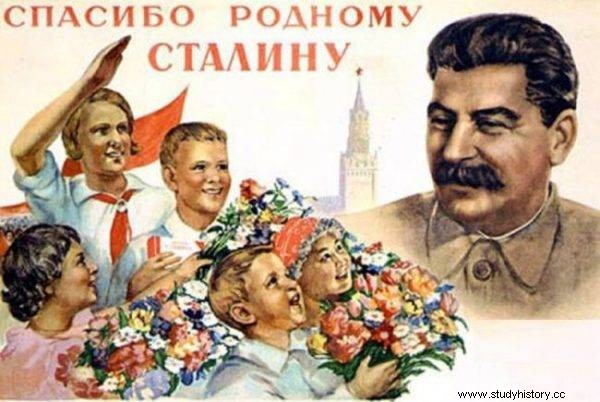
"Thank you Comrade Stalin for our happy childhood" in 1936.
You became an enemy of the nation with the whole family. If the alleged spy lived with the woman, she would become a member of the Motherland Traitor's Family - and she also ended up in a labor camp. Magdalena Grzebałkowska in her latest book "Wojenka" describes:
If they both had children, each of them would become an enemy of the nation and must, together with their mother, be sentenced to exile and then rehabilitated at home for the children of the nation's enemies. It may happen that the enemy of the nation gives birth to the enemy of the nation already in the labor camp. Then such a child should be taken from the mother and transferred to the above-mentioned orphanage.
Each day of a minor enemy of the nation must begin with a common, cheerful exclamation:- Thank you, Comrade Stalin, for our happy childhood!
"The Soviet government does not punish but educates"
What was this "happy childhood" like?
We rarely have meat, and in very small amounts. Only dark bread, and we haven't seen any sugar for three months. The younger ones cannot stand it, they collect the potato peelings and eat them. Sometimes, due to the lack of other products, we cook oat groats - a kind of pig slime. […]
Children wear the same underwear for months, and sometimes even longer, without taking them off because there is nothing to change. There is a smoke in the bathhouse twice a month and even then the children have to wash without soap, so parasites attack them. There is no bed linen, there are mattresses, but they have not been cleaned in a year, the blankets are in shreds and are swarming with lice.
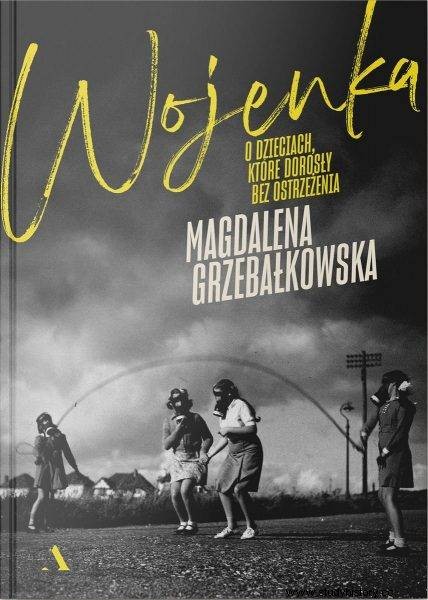
The text was created, among others based on the book by Magdalena Grzebałkowska "Wojenka. About children who grew up without warning ”, published by Agora publishing house.
This dramatic description comes from a letter written by the inhabitants of the orphanage in the village of Mojka in 1926, but - as Anne Applebaum points out - it was a typical description of an orphanage in Soviet times and could have been created at any time in the 1920s, 1930s or 1940s.
The situation of small labor camps was even more difficult. As enemies of the nation, and additionally unfit for work due to their age, they did not represent a greater value for the commandant of the camps. Despite the official line of propaganda saying that "the Soviet government does not punish, but educates", for children in labor camps, everyday life itself was supposed to be a form of punishment . As Applebaum describes:
They were mostly quartered in the worst, oldest and worst heated buildings - one inspector found that the temperature in nursing barracks never exceeds 11 degrees Celsius; another came to an orphanage where paint peeled off the walls and there was no lighting, not even kerosene lamps.
Angel factories
Soviet orphanages were called "angel factories" already in the 1920s. Nowhere, however, was this term so brutally accurate as in the labor camps. It began with the very birth. Magdalena Grzebałkowska in "Wojenka" describes the care of babies considered "socially dangerous":
Three times a day, the women enter the nursery barrack in the AŁŻIR labor camp, in complete silence. They unfasten their shirts, put the children given to them by their carers to their breasts. (…) The children of the enemies of the nation are to grow up into people of the future, without family sentiments. The women who gave birth to them should remain alien to them, therefore they are not allowed to speak to their daughters and sons, smile or sing to them. Whoever talks to his own baby while feeding will be punished.
When the women were running out of food, they were forbidden to come any longer.
Meanwhile, the little ones were left to themselves. One of the prisoners born in the labor camp, Lilia Salomonowna Wiercholewska, whose story is described in her book by Grzebałkowska, recalled that until the children learned to walk, they lay in cots. There was no talk of affection, songs, toys.
The babysitters were only supposed to keep the babies alive. Besides, it did not always work out.
Plant life
Once the children mastered the ability to walk, they were taken outside, in front of the barracks. Another protagonist of "Wojenka", Georgy Karitnikov, who spent the first years of his life in a gentle dugout (an alternative to a nursery, about which the camp authorities did not officially know), described:
We knew the life of plants . You could say that for seven years I slept, ate, sat on the bed or walked. Nobody taught us anything, nobody talked to us about anything, didn't play with us, didn't sing songs . I couldn't read or write, my vocabulary was very poor. I don't think the contacts between the children were too great, since I don't remember anyone from that time anymore.
The fate of the children from the dugout and those from the nursery barracks did not differ much - all starved the same way. They all fell ill and died one by one. They all lacked maternal care . Only that the latter had to leave the nursery after three years to undergo "rehabilitation" in the orphanage.
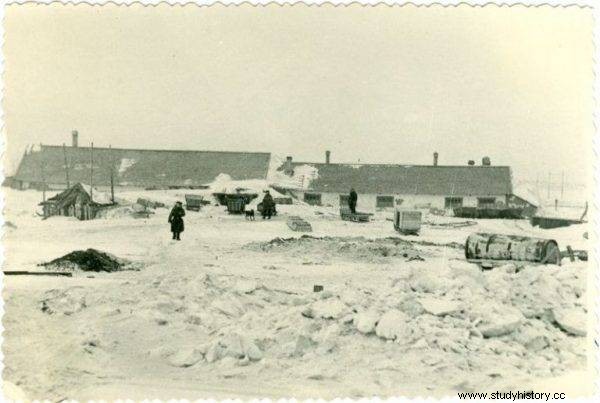
The fate of the children from the dugout and those from the nursery barracks did not differ much - they all starved the same. They all fell ill and died one by one. They all lacked maternal care as well.
Evgenia Ginzburg, who worked as a tutor in the camp orphanage, recalled that most of the toddlers who went to preschool institutions could not even speak. Only some four-year-olds uttered single words:
"Look," I told Stasik, showing him the house I had drawn. - What is this? "Barak," the boy answered quite clearly. With a few pencil strokes I placed the kitten next to the house. But no one recognized him, not even Stasik. They had never seen such a rare animal. Then I led the house along an idyllic traditional fence. - What's this? - Wife! Wife! - joyfully exclaimed Wieroczka and clapped her hands.
Death to the enemies of the motherland
As Magdalena Grzebałkowska lists in "Wojenka", in the so-called AŁŻIR (Akmolinski Łagrze Żon Traitors Ojczyzny, Akmolinskij Łagier ’Żon Izmiennikow Rodina), which is part of a 200 kilometers wide and 300 kilometers along Karłag, 1507 children were born in the years 1938–1953. Only a hundred survived. And it was only one of the islands of the Gulag archipelago.
The mortality rate among toddlers who came to the labor camps with their mothers was equally tragic. "In winter, when they cannot be buried because the ground is frozen, their bodies are put in barrels, where they are to wait until spring" - writes the author of "Wojenka".
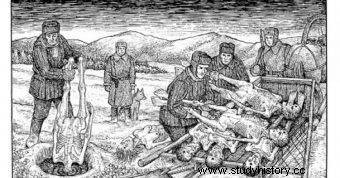
The prisoners of the Soviet labor camps were subjected to inhuman torture. Illustration from the book "Drawings from the Gulag" by D. Baldaev
In some orphanages, children were starving. Previously, they ate the grass within yards of the barracks. Other toddlers were dying to death by infectious diseases. Julian Better, who was born in prison, recalled:
Here I have a scar - traces of boils. This is called furunculosis, or furunculosis. It is fatal. The boils go through the skin inward, it gets blood poisoning, pus, terrible things. But I was lucky.
Imagine that I found an instruction from Yezhov himself, the then chief of the NKVD, to disinfect baby bathtubs, because it was terribly contagious, it took a great toll among children. But how could they do it under these conditions! (...) There weren't really any medications. We were not entitled to medication at all and; if they were, it was for the "free". Whoever survived, survived.
Tuberculosis and dysentery, or dysentery, also took a bloody toll.
Wolf children
Despite this, Soviet propaganda did its job - surprisingly, also among the Gulag prisoners. It poured out of radios and televisions, attacked from posters on walls and newspapers. It was repeated in schools and at party meetings.
Anne Applebaum notes that " she triumphed over the daily experience that showed that her view of the world differed from reality ". Lilia also found out about it, as she reveals on the pages of "Wojenka":
I was such a stupid patriot. I loved Stalin so much that when he died, I thought it was better for me to die too. I despaired so much that it is impossible to describe it. And my mother just said, "That animal should have died a long time ago." Then I screamed:"You can see that you were right in the labor camp."
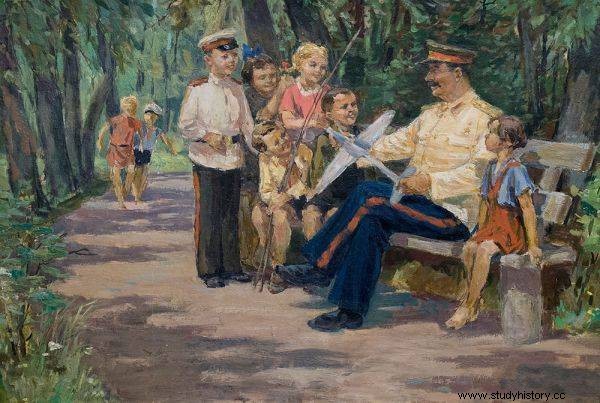
"Stalin with the children." Oil painting by Wiktor Jakowlewicz Konovalov from the 1950s.
And she sadly adds:“We, foster children from orphanages, were like wolves, rough on the outside, but good on the inside, but we couldn't afford to show our feelings. After that, my mother and I became very close, but I never said the word "I love" in my life, I never hugged her, never kissed her. It's hard to even imagine. ”
Bibliography:
- A. Applebaum, Gulag , Agora 2018.
- C. A. Frierson, S. S. Wileński, Children of the Gulag , PWN 2011.
- M. Grzebałkowska, Wojenka. About children who grew up without warning , Agora 2021.
- D. Passent, I was a child of the gulag , "Przegląd" (access:May 23, 2021).
